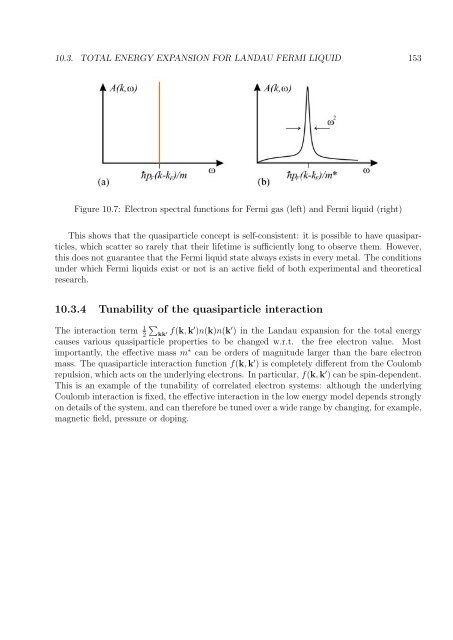Set of supplementary notes.
Set of supplementary notes.
Set of supplementary notes.
Create successful ePaper yourself
Turn your PDF publications into a flip-book with our unique Google optimized e-Paper software.
10.3. TOTAL ENERGY EXPANSION FOR LANDAU FERMI LIQUID 153<br />
Figure 10.7: Electron spectral functions for Fermi gas (left) and Fermi liquid (right)<br />
This shows that the quasiparticle concept is self-consistent: it is possible to have quasiparticles,<br />
which scatter so rarely that their lifetime is sufficiently long to observe them. However,<br />
this does not guarantee that the Fermi liquid state always exists in every metal. The conditions<br />
under which Fermi liquids exist or not is an active field <strong>of</strong> both experimental and theoretical<br />
research.<br />
10.3.4 Tunability <strong>of</strong> the quasiparticle interaction<br />
∑<br />
The interaction term 1 2 kk<br />
f(k, k ′ )n(k)n(k ′ ) in the Landau expansion for the total energy<br />
′<br />
causes various quasiparticle properties to be changed w.r.t. the free electron value. Most<br />
importantly, the effective mass m ∗ can be orders <strong>of</strong> magnitude larger than the bare electron<br />
mass. The quasiparticle interaction function f(k, k ′ ) is completely different from the Coulomb<br />
repulsion, which acts on the underlying electrons. In particular, f(k, k ′ ) can be spin-dependent.<br />
This is an example <strong>of</strong> the tunability <strong>of</strong> correlated electron systems: although the underlying<br />
Coulomb interaction is fixed, the effective interaction in the low energy model depends strongly<br />
on details <strong>of</strong> the system, and can therefore be tuned over a wide range by changing, for example,<br />
magnetic field, pressure or doping.








